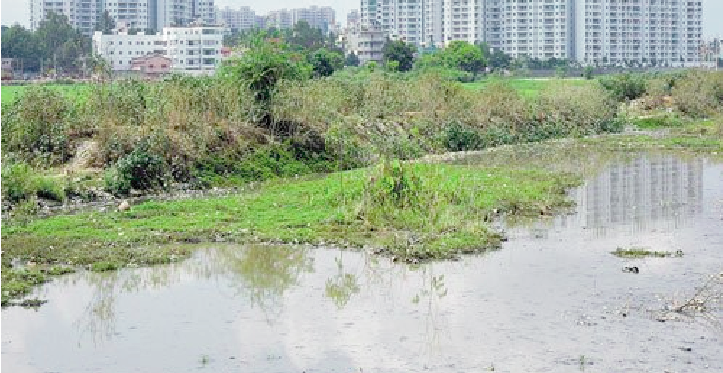Mumbai in the early eighties was different. It was less crowded, green, and had less traffic than what we see now. My childhood was shared between Dadar’s Shivaji Park area at one end, and suburban Chembur at the other. An only child of working parents, till the age of 10, I would be dropped off at my maternal grandmother’s home in Shivaji Park (where she would babysit me while my mom went off to work) in the mornings, and return to our home in (the then green and pristine) Chembur in the evenings.
At that time, there used to be only two public buses operating from Dadar to Chembur, and we would often find ourselves making a halt at Sion to change or catch a connecting bus. The reason I am sharing this tale is because in the eighties, Sion too wasn’t the crowded junction that we see today. The bus stop at Sion where we used to wait for the bus, stood next to a huge lake. Calm and clean, it used to be quite a treat to view the life that went around the many trees surrounding it, and the birds that adorned them.
Our bus to Chembur would pass through a long stretch of wetlands on both sides of the road (now the Sion highway), and the marshes that spread far and wide. In between the marshes, one could see spots of water bodies, ponds, and mangroves. Sometimes we took the train from Dadar, and in such cases, we would disembark at Kurla station and walk all the way upto Chembur (many times there were no autos, especially during the monsoons), passing by several smaller ponds and lakes on our way.
Vanishing heritage
Over the years, the big lake where I stood waiting for the bus has vanished. A small part of the lake’s end is being used for immersion of Ganesh idols during Ganpati festivals. While the wetlands that graced the Sion highways too are no more, concrete structures now stand on it. Similarly, the small ponds and lakes in Kurla too are gone. They have been replaced with buildings that house residential complexes and offices. There are hardly any signs of any lakes or ponds here.
Mumbai had a fairly large number of water bodies in the form of ponds, lakes, catchment areas, wetlands, and mangroves, which over the years have slowly been filled up or dried out to make way for construction projects. Water bodies, floodplains in most low lying parts of Mumbai, were protectors of the city from the rains — they drained off the overload of rains that poured in. But construction over these water bodies not only blocked off the water, but also created extensive water logging in the city. The situation continues to escalate every year, as more and more construction sites are added to the city, and the areas continue to be concretised.
I recall one such lake in the plush area of Seven Bungalows which too was filled up to create a jogging track, and a garden for local residents. Or the smaller fish ponds at Mira Road that have been encroached upon, and have been asphalted permanently.
Villages not far behind
Like the cities, our villages too are not far behind when it comes to vanishing water bodies. My first visit to a village outside Mumbai was to Guptipara, a small town nestled in Hooghly district in West Bengal renowned for its terracotta temples, and famous for starting the first community Durga Puja in the country. Guptipara in the late nineties was a dream. With the River Bhagirathi flowing through it, the village blessed with lush greenery and several ponds and lakes too, has gone the urban way.
In a bid to capitalise on the rising property prices, residents have taken to selling off their ancestral properties or turning themselves into local builders and filling up their centuries old fish ponds with debris to construct ugly concrete structures, that are a misfit with their local surroundings.
Over the last decade or so, many such villages in the district have lost their green cover. Similarly, across many villages of India, under guise of development, natural water bodies—lakes and ponds – are being filled up for construction projects. These ponds, streams and rivulets are erased from our maps, their absence creating grounds for man-made disasters. Putting up construction on these water bodies that act as natural drainage basins, causes irreversible damage to the environmental structure. Furthermore, construction alone does not seem to be the problem for the disappearance of our lakes. The failure to identify and correct the neglect of one of our most treasured natural resource is definitely on us.
While there are strict laws within government norms to protect these water bodies, sadly, no one seems to care. Encroachments on water bodies invite heavy fines as well as imprisonment, but interestingly, these stringent laws are not implemented in most cases.
Courts to the rescue
Thankfully, it is our courts, the highest constitutional authorities, who are doing the job. They are the ones who are coming to the rescue of the water bodies. Like in the year 2014, when responding to a Public Interest Litigation (PIL), a Madurai bench of the Madras High Court gave a historic judgement directing the then government not to grant permissions to construct buildings on lands located on water bodies.
A year earlier, the Supreme Court had directed officials at the Kanpur Dehat District to keep a check on the water encroachments in their area. Before that, the Rajasthan High Court too had pulled up its own government over illegal encroachments and allotments on the many catchment areas of water bodies. Recently in 2018, the Supreme Court had directed the Delhi Jal Board to revive the water bodies in the state.
Should we be dependent on our courts to do the job for us? It is high time that we as concerned citizens also take equal responsibility for this mess that we have created, and act upon on it soon. The writing is on the wall. Our cities are flooding every monsoon. People are losing lives due to such over flooding, and the earth is getting warmer and hotter day by day. We are the reason for the climate change. And we cannot remain ignorant for long. Ignorance cannot be bliss anymore, because reality has already come to bite us.


 [/column]
[/column]